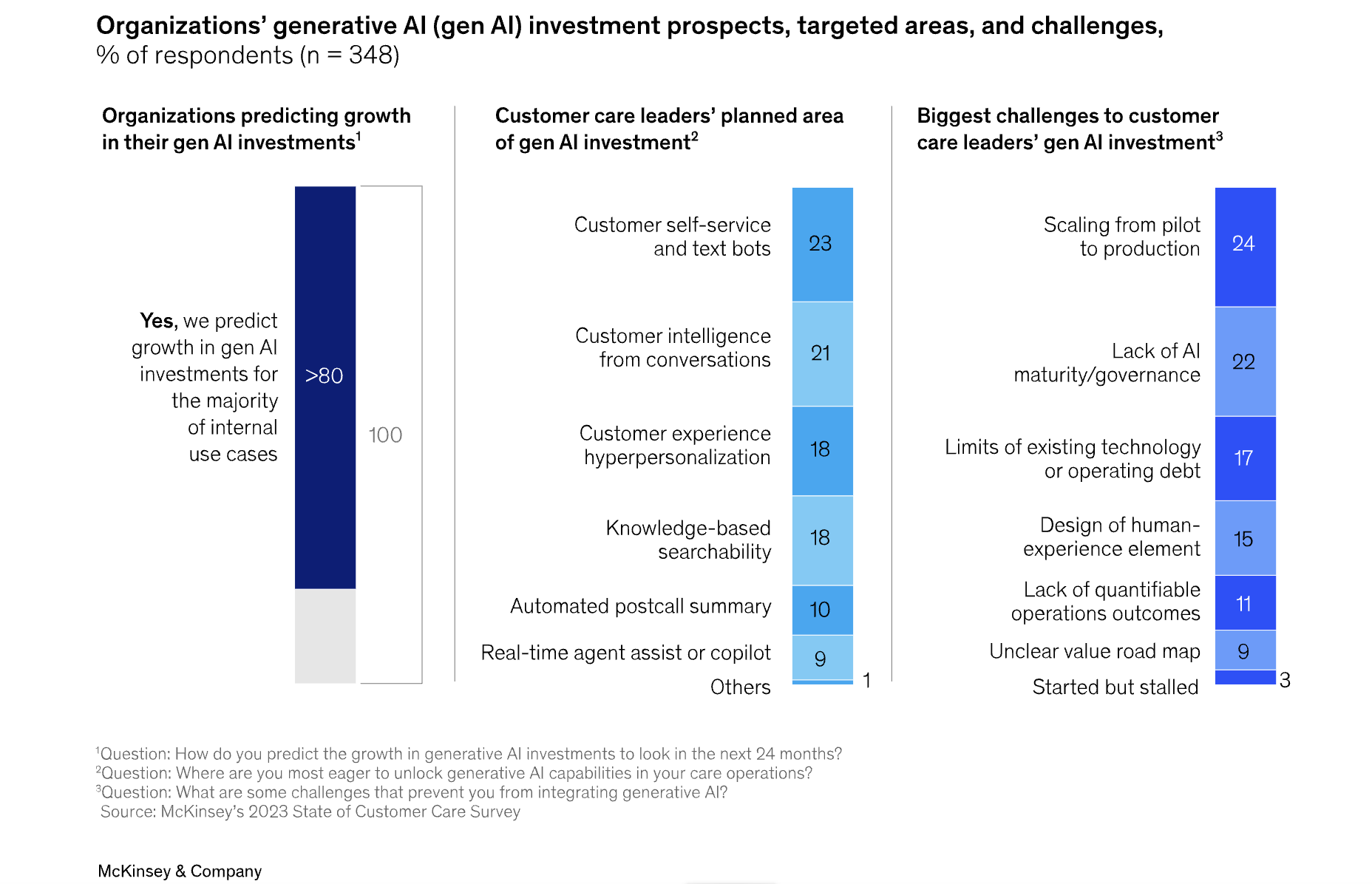Elevate CX by closing the gaps in your contact center tech stack

Consumer expectations for the customer experience (CX) aren’t what they used to be. Today’s consumers require consistent, personalized, and high-quality service at every point in their journey.
Contact centers are facing increased pressure to surpass these expectations. Fifty-seven percent of customer care executives surveyed by McKinsey say they see call volumes rising as much as 20% over the next couple of years. While that means more opportunities to impress, companies will face stiff competition. According to IDC, 60% of the Fortune 500 will “leverage ubiquitous experiences, edge analytics, and GenAI to enable customers to create their own experience journeys, improving customer-desired outcomes and value.”

However, contact centers are finding it challenging to engage and deliver consistently personalized, valuable interactions at each point in the customer journey. The reason becomes clear when you look at the contact center technology stack. In the race to implement cutting-edge technologies designed to elevate the CX, companies invested in point solutions. The result was a collection of contact center technologies that don’t talk to each other.
Companies are caught in a paradox. Even with best-in-class technologies in place, the customer journey is disjointed—and the CX fails to rise to consumer expectations.
The evolution of the contact center tech stack
To better understand what today’s contact center tech stack looks like, it’s helpful to look at how much it has changed over the past 25 years. What began as a relatively simple set of core systems has grown into a complex ecosystem of diverse technologies and channels serving a variety of needs.
Contact centers once relied primarily on a handful of essential systems, such as:
Interactive voice response (IVR) and automatic call distribution (ACD) tools, often from the same provider
Customer relationship management (CRM) systems for customer records
Workforce management tools
Reporting platforms
Knowledge management systems
Occasional legacy system connections (e.g., mainframe)
This was the state of the contact center tech stack until digital-first companies like Amazon reset consumer expectations. Customers began to look for the same unified journey from every business they interacted with. Today, they compare experiences not just within sectors but across industries, and if they’re less than satisfied, they can easily switch to another provider.
Under increased pressure to meet these heightened expectations, companies rushed to implement technologies that served specific points in the customer journey.
Fast forward to today, and the contact center tech stack has transformed dramatically. It now includes technologies such as:
Multiple communication channels (voice, email, chat, social media, etc.)
Best-in-class third-party applications
Workforce optimization
Real-time transcription and speech analytics
Natural language processing (NLP) and chatbots
However, this reactive approach had unintended consequences. It led to siloed technologies and broken processes. It also increased the complexity of systems integrations. Although companies have realized numerous benefits, they also have significant challenges to overcome, including:
Achieving interoperability between diverse systems
Managing and consolidating data from multiple sources
Maintaining comprehensive reporting across the entire stack
Close the gaps: the power of AI + automation
Since a disjointed tech stack leads to a disjointed customer experience, companies must resolve these issues in order to deliver a unified customer journey. Yet, it’s not realistic to replace or hardwire integrate them.
Fortunately, there’s a simpler option. Companies can use automation to connect the customer journey across platforms, bridging the gap between incompatible technologies and creating smoother contact center processes that span functional silos.
For instance, to solve a customer problem, contact center agents need information about both the customer and the product. Software robots can pull this information together in seconds. With the right customer information at hand, contact center agents can deliver a more personalized experience. After the call, software robots can handle actions such as updating customer records or placing orders.
CXP, a contact center outsourcing specialist, saw a 52% increase in its Trust Pilot ratings when it deployed robots to provide data to agents. Software robots are used to gather data from multiple systems and provide the information to agents when calls come in. Issues are resolved faster, and since interactions are more personalized, customers have a better overall experience.
When combined with AI, robots can also read and understand documents, extract data, and complete forms. Automating repetitive tasks reduces the workload of contact center agents so they can spend more time creating the type of interactions that customers will remember and value.
DNA Plc, the largest full-service telecommunications provider in Finland, saves approximately 3,250 hours every month by using robots to update its mobile subscription database. The result was a tenfold improvement in performance and much greater accuracy.
The B2B side of our company offers many business services including mobile services. When a change came in from a customer, it had to be manually entered into the mobile subscription database. This was time-consuming and prone to error. Within six weeks, we had created a working robot that had automated the task. The results were very, very good.
Salla Valkonen, Head of Process Automation, DNA Plc
Combining AI and automation can help companies create and scale omnichannel communications. Self-serve tools like chatbots can allow customers to solve issues faster and without the help of an agent, leading to a better overall experience.
AI + automation makes it easier for companies to close the gaps in their contact center tech stacks. It enables them to:
Integrate front and back-office systems
Unify customer and operational data across multiple channels
Focus on delivering customer-desired outcomes and value, rather than just experiences
Additionally, AI + automation is transformational for both the customer experience and the contact center agent experience.
Enhanced self-service capabilities allow customers to self-resolve issues, enabling agents to focus on more complex and complicated problems.
Real-time insights and predictive analytics empower contact center agents to provide more personalized interactions and deliver better customer service.
From siloed to strategic: unifying the customer journey
Elevating the CX requires a strategic approach that balances technological innovation with a deep understanding of customer needs and expectations. By focusing on integration, data unification, and AI-driven solutions, companies can overcome the challenges of fragmented systems and deliver truly exceptional customer experiences.
With AI + automation, businesses can deliver personalized experiences at scale, analyzing customer data in real-time to predict needs and tailor interactions accordingly. The combination of routine task automation and intelligent assistance for human agents also improves operational efficiency.
To dive deeper into best CX practices and learn more about scaling value in customer experience, be sure to check out the "Demystifying the Contact Center" episode in the UiPath podcast series.
Have more time? Register once and get access to all sessions of the UiPath Customer Experience Summit. Watch the replays at your convenience.

Product Marketing Intern, UiPath
Get articles from automation experts in your inbox
SubscribeGet articles from automation experts in your inbox
Sign up today and we'll email you the newest articles every week.
Thank you for subscribing!
Thank you for subscribing! Each week, we'll send the best automation blog posts straight to your inbox.



